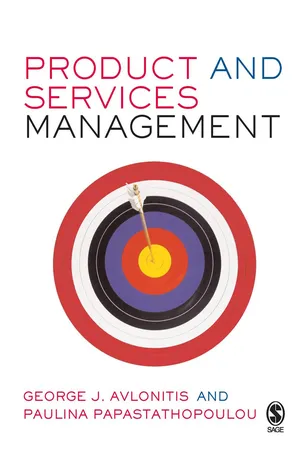
- 280 pages
- English
- ePUB (mobile friendly)
- Available on iOS & Android
Product and Services Management
About this book
`A text that successfully bridges the gap between academic theorizing and practitioner applicability because it uses multiple real-world examples/mini-cases of management techniques to illustrate the well-researched academic theoretical foundations of the book? - Creativity and Innovation Management
`A complete and useful treatment of the domain of product and service decisions. This book is unique in its treatment, dealing with product and service portfolio evaluation, new product/service development and product/service elimination in an integrated manner. Enlivened by many mini-cases, the book provides a soup-to-nuts approach that will prove very attractive for students and be a valuable reference for managers as well. Highly recommended? - Gary L Lilien, Distinguished Research Professor of Management Science, Penn State University
`Product and Services Management (PSM) is a welcome, up to date summary of the key issues facing firms in developing and refreshing their portfolios. The examples and cases bring the academic arguments clearly into focus and demonstrate the crucial role of PSM in leading the overall strategy of the firm? -
Professor Graham Hooley, Senior Pro-Vice-Chancellor, Aston University, Birmingham
`Managers responsible for and students interested in product portfolio decisions previously had to consult several sources for obtaining up-to-date information; books on new product development, articles on service development, readers on product management, and frameworks for product evaluation and termination. With the book Product and Services Management the reader obtains four-in-one. Avlonitis and Papastathopoulou reveal in a compelling and comprehensive manner why product decisions are the cornerstone of modern marketing and business, and illustrate the theory with numerous mini-cases from Europe and elsewhere. A must read for everyone with a passion for products? - Dr Erik Jan Hultink, Professor of New Product Marketing, Delft University of Technology
This book provides a holistic approach to the study of product and services management. It looks at the key milestones within a product?s or service life cycle and considers in detail three crucial areas within product management, namely product/service portfolio evaluation, new product/service development and product/service elimination.
Based on research conducted in Europe and North America, this book includes revealing cases studies that will help students make important connections between theory and practice.
The pedagogical features provided in each chapter include chapter introduction, summary, questions and a further reading section. Additional material for instructors include PowerPoint slides and indicative answers to each chapter?s questions.
This book is written for undergraduate and postgraduate students of business administration who are pursuing courses in marketing, product portfolio management, new product development and product policy.
Frequently asked questions
- Essential is ideal for learners and professionals who enjoy exploring a wide range of subjects. Access the Essential Library with 800,000+ trusted titles and best-sellers across business, personal growth, and the humanities. Includes unlimited reading time and Standard Read Aloud voice.
- Complete: Perfect for advanced learners and researchers needing full, unrestricted access. Unlock 1.4M+ books across hundreds of subjects, including academic and specialized titles. The Complete Plan also includes advanced features like Premium Read Aloud and Research Assistant.
Please note we cannot support devices running on iOS 13 and Android 7 or earlier. Learn more about using the app.
Information
1 | The Product as an Economic Variable |
Introduction
- How does the economics and marketing literature treat the product concept?
- Which are the main product-related concepts?
- Which are the various product classification schemes on the basis of tangibility, durability and use?
Historical overview of the product concept
Main product-related concepts
Product levels
- Core benefit – refers to the main benefit the customer buys (for example, the buyer of a vehicle purchases ‘transportation’).
- Basic product – refers to the basic characteristics or attributes of the product, without which there is no product (for example, tyres of a car).
- Expected product – refers to the characteristics of the product that the customer takes for granted (for example, tyres in a good condition).
- Augmented product – refers to the product characteristics that surpass the customer’s expectations (for example, road assistance).
- Potential product – refers to those characteristics that could be added to the product in the future and offer customer delight.
Product hierarchy
- Need family – the basic need underlying the existence of a product family (for example, security).
- Product family – all the product classes that can satisfy a basic need effectively (for example, savings and income).
- Product class or category – a group of products within a product family (for example, investment products).
- Product line – a group of products within a product class, which are closely related because they are targeted to the market, through the same distribution channels or are priced within a specific range (for example, investment accounts).
- Product type – a group of items within a product line that function in a similar manner (for example, capital guaranteed accounts).
- Brand – the name of a product (for example, Dunbar Bank).
- Item – a unit within a brand or product line which is distinguished by size, price, or some other characteristic of element (for example, the FTSE 100 index).
Product life cycle
Table of contents
- Cover Page
- Title
- Copyright
- Contents
- 1 The Product as an Economic Variable
- 2 Types of Product Decisions
- 3 Product Life Cycle and Marketing Strategy
- 4 Evaluation of Product/Service Portfolio
- 5 New Product/Service Development and Portfolio Models
- 6 Pre-Development Activities of New Products and Services
- 7 Development, Testing and Launching New Products and Services
- 8 Successful Adoption and Diffusion of New Products and Services
- 9 Identification and Revitalization of Weak Products and Services
- 10 Evaluation of Weak Products/Services and Elimination Strategies
- 11 Organizational Arrangements for Developing, Managing and Eliminating Products and Services
- Appendix 1 New Product Budget
- Index